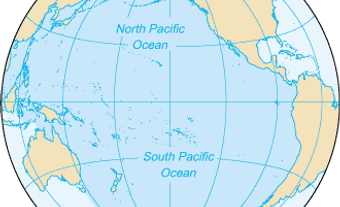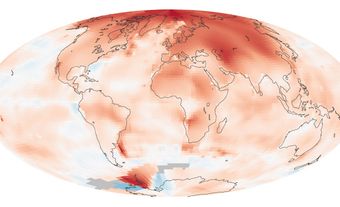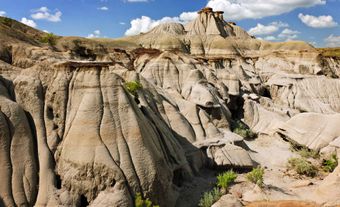An Alberta Clipper is a type of low-pressure weather system that forms in Alberta or nearby, on the eastern side of the Rocky Mountains. It is a fast-moving storm, hence the name “clipper,” which refers to 19th-century ships known for their speed. Depending on the province where the system approaches the Canada-United States border, sometimes it is called a Saskatchewan Screamer, Manitoba Mauler or Ontario Scary-o. It may also be called a Canadian Clipper or simply a Clipper. Such storms mostly occur in December and January but are common in the fall and spring, too. They form about 5–20 times per season.
Formation

Alberta Clippers form in the lee of the Rocky Mountains — the downwind, eastern side. The formation occurs following the arrival of a Pacific low-pressure system on the west coast. As that system moves eastward, it brings increased wind flow across the mountains. This creates a lee trough — an area of low pressure in the lee, or sheltered side, of the mountains. The counter-clockwise motion of the Pacific system is then transferred to this new system. As it builds up, it remains stationary for some time, then begins to move quickly across the continent.
Did you know?
Low-pressure systems form when air rises from the Earth’s surface towards the upper atmosphere, usually because the air is warming up. They are called low-pressure systems because there is less atmospheric pressure at the centre of the system than there is around it. As the air ascends, it carries moisture from near the surface, which may turn into clouds, then precipitation. Air surrounding the rising air will move towards the area underneath to “fill in” the open space. Because of the Earth’s rotation, this inward-moving air rotates around the space it is filling. In the northern hemisphere, this rotation is counter-clockwise. The air’s rotation is often the main source of the winds that come with a low-pressure system.
Characteristics
Alberta Clippers are typically low in moisture. This is because much of the water vapour contained in the Pacific system is released as rain or snow as the air ascends the Rocky Mountains. This precipitation is due to a process called adiabatic cooling. As the air ascends the Rockies, it expands because the ambient pressure decreases with altitude. This expansion involves a loss of energy, which translates to a drop in the air’s temperature. Since colder air cannot hold as much water vapour, the vapour condenses into liquid water and ice crystals, which become precipitation. The air coming down the eastern slope of the Rockies warms up again, following the opposite process: adiabatic warming. However, much of its moisture was lost earlier when precipitation occurred. This makes the air very dry. This warm, dry downslope wind is sometimes called a chinook, and can contribute to forming a Clipper system.

Trajectory and Evolution
Once formed, the average Alberta Clipper moves across the continent at about 35 km/h, with fast-moving air rotating around its centre. Its path is influenced by the polar jet stream — the dominant wind pattern in the upper atmosphere over North America. Most Clippers travel eastward and southeastward, into south-central Canada and sometimes the north-central or northeastern United States, then finally into the Atlantic Ocean. This entire journey usually takes about 3–5 days. The jet stream’s trajectory changes with seasonal and atmospheric cycles, so the system may take different paths. Some Clippers travel as far south as Arkansas and South Carolina, while others sweep as far north as northern Ontario and northern Quebec. Overall, less than 1 in 10 Alberta Clippers track south of the Great Lakes. When they do it’s usually during La Niña, a climate phenomenon that causes the polar jet stream to plunge much farther south than usual.
Effects

In most cases, Alberta Clippers have less impact on the weather than most storms. Because they move quickly and are low in moisture, the precipitation they bring is scarce and spread over broad areas. However, this can change if they pick up significant moisture. This often happens when crossing over the Great Lakes, for example. When this “lake effect” occurs, nearby regions may receive up to 30 cm of snow. This snow mostly falls north of the system’s track. Clippers also bring winds that can exceed 65 km/h, often causing blizzard conditions when snow is present. These winds usher in bitter cold. Temperatures may drop by as much as 16°C in 10 to 12 hours.
Climate Change
The effects of climate change on local weather patterns tend to be complex and uncertain. Still, it is possible to identify a few trends that may affect Alberta Clippers in the future. Some have already begun to take place. First, on a global scale, warming temperatures tend to favour evaporation, which brings more moisture into the atmosphere. This may mean that Alberta Clippers will bring a bit more precipitation in the future. Second, Alberta Clippers may be influenced by a phenomenon called Arctic amplification. Simply put, the Arctic is warming faster than the Earth’s average temperature is warming. Because the movement of air in the atmosphere is connected to the difference in temperature between the poles and the equator, a warming Arctic affects the global movement of air. Arctic amplification tends to slow down the west-to-east movement of air in regions such as North America. This may slow Alberta Clippers down slightly, causing them to concentrate precipitations over smaller areas. They would then become more potent storms. Arctic amplification would also seem to be responsible for changes in the shape of the jet stream. This, in turn, affects the trajectories that Clippers follow. Third, it is projected that the broad climatic phenomena El Niño and La Niña may become more frequent and pronounced as global temperatures continue to rise. These influence the trajectory of the jet stream, too. When La Niña is present, Clippers tend to move farther to the south. On the other hand, during El Niño periods, Clippers move more directly east. The combination of all these effects may change how Alberta Clippers behave in the future.

 Share on Facebook
Share on Facebook Share on X
Share on X Share by Email
Share by Email Share on Google Classroom
Share on Google Classroom



